Top 5 Most Beautiful Historical Sites in Algeria
Algeria is in a vast desert Sahara, with warm Mediterranean Sea waters, majestic mountain ranges, oriental color, and a vibrant mix of many cultures. Many ... read more...Algerian landmarks were shaped by the impact of various peoples, religions, and civilizations. The following are the 5 most beautiful historical sites in Algeria to help you plan your future trip.
-
M'zab Valley is a natural location in Algeria's Ghardaïa Province in the northern Sahara Desert. It lies 600 kilometers (370 miles) south of Algiers. The Mozabites are a branch of the Iznaten, a vast Berber tribe that once occupied huge swaths of central and southern Algeria. Around the M'zab Valley, Tifinagh letters and symbols are engraved.
The Pentapolis is a group of five qsur "walled villages" (ksour) perched on rocky outcrops along the Wəd Mzab, founded between 1012 and 1350. The five communities are Ghardaïa (Tagherdayt), the most important today; Beni Isguen (At Isjen); Melika (At Mlishet); Bounoura (At Bunur); and El Atteuf (Tajnint), the oldest.
As one of the most beautiful historical sites in Algeria, each citadel contains a fortress-like mosque with a lookout in the minaret. Around the mosque, standard-sized and-type houses were built in concentric circles. The M'zab villages were built with egalitarian communal living in mind, while also respecting family privacy. The M'zab architectural style is Libyan-Phoenician in origin, more specifically Berber in origin, and has been copied throughout the Sahara.
In 1982, the UNESCO World Heritage Site of the M'zab Valley was designated as an intact illustration of traditional human habitat perfectly adapted to the environment.
Location: Ghardaïa Province, Algeria
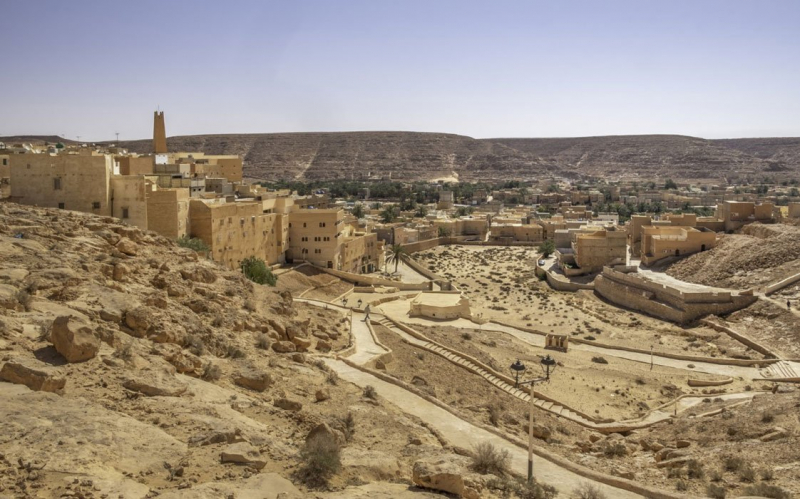
Photo: ancient-origins.net Video: UNESCO -
A massive sand monolith lies about 25 kilometers from the oasis of Djanet in southeast Algeria, on the eastern edge of erg Admer towards Tassili n'Ajjer in the Tigharghart region. The rock engravings of La vache qui pleure (the wailing cow), which date back over 7000 years, can be found on one side of the monolith's rocks.
As one of the most beautiful historical sites in Algeria, the rock engravings of La vache qui pleure are a Neolithic sculpture masterpiece. The engravings, which are constructed of deep grooves etched into the rock and carried out in bas-relief, are of amazing artistry and harmony. The engravings depict a small herd of bovidae leaning against a little depression at the foot of the rock. The tear dropped by one of these cows has spawned a slew of stories and interpretations.
A tear falls from a cow's eye while being milked, according to a bas-relief in the coffin of queen Khouit, wife of Pharaoh Mentuhotep II of the 11th Dynasty.
Location: Djanet, Algeria
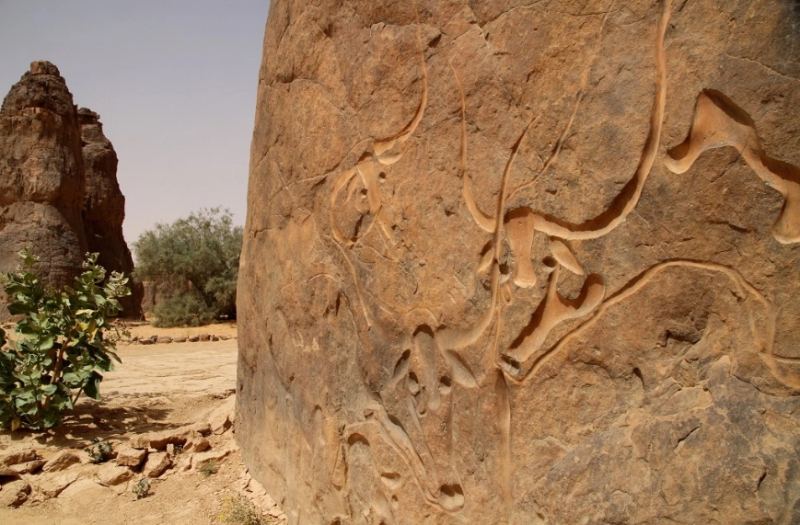
Photo: viaggiaredove.com Video: La vache qui pleure Tassili N'ajjer -
Khamissa, also known as Thubursicum Numidarum or Thubursicum, is an old Roman and Byzantine archeological site in northeastern Algeria's Souk Ahras Province.
Khamissa lies 40 kilometers (25 miles) southeast of Guelma, known as Calama by ancient Roman settlers, and 32 kilometers (20 miles) northwest of Souk Ahras, known as Thagaste by ancient Berbers and Romans. . It is located around 250 kilometers (160 miles) west of Carthage.
Originally, the site was a primary settlement of a Numidian Berber tribe. This is most likely the city to which Tacitus refers in connection with the insurrection of Tacfarinas during Tiberius' reign (15 CE to 24 CE). Khamissa, previously known as Thubursicum, was a Roman town in the Maghreb created approximately 100 CE by Emperor Trajan, who advanced it to the status of municipium (Municipium Ulpium Traianum Augustum Thubursicu). Its inhabitants became members of the Papiria tribe. By 270 CE, it had become a colonia (Roman colony).
Khamissa became the seat of a bishopric, with a rectangular basilica with marble walls built in the second century. Augustine of Hippo (St. Augustine) visited it twice. From 391 to 430, he served as a priest, coadjutor Bishop, and Bishop in the regionally local Hippo Regius.
From 435 until 534, the town was a member of the Vandalic Kingdom of Carthage. In 534, the East Roman Empire (Byzantine Empire) reconquered it during the Vandalic War and built a Byzantine-style chapel and modest forts. It was under the control of the Byzantine Praetorian Prefecture of Africa and the Exarchate of Africa until the Muslim conquest of the Maghreb in 698.
Archaeological excavations from 1900 to 1922 cleared only a small portion of the settlement site. The majority of the artifacts collected during the time, particularly the Ancient Roman statues, are now housed at the Guelma Museum in Algeria.
Location: Souk Ahras Province, Algeria
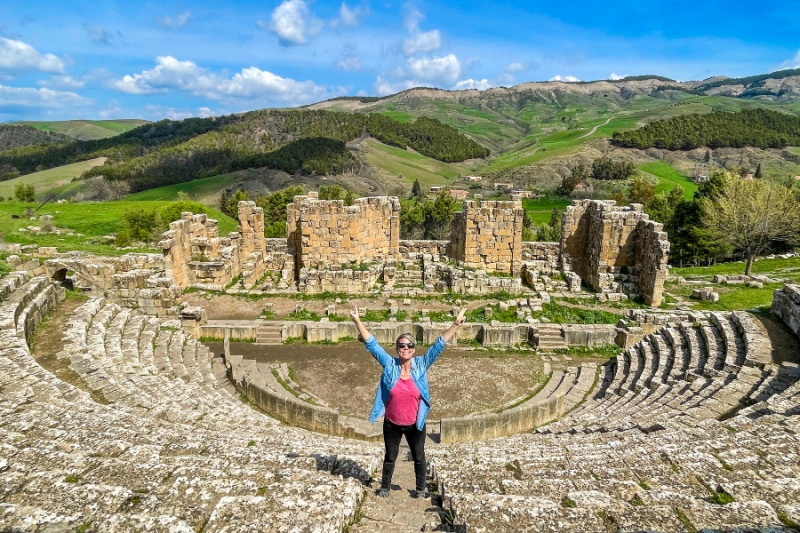
Photo: veryhungrynomads.com Video: صحة health -
Fort of Santa Cruz is one of three forts in Oran, Algeria's second-largest port city; the other two forts are Fort de la Moune at the harbor's western end and Fort Saint-Philippe, a replacement for the old Saints Castle, known in Spanish as Castillo de los Santos, in the city center. Tunnels connect the three fortresses. The Spaniards erected Fort Santa Cruz between 1577 and 1604 on the Pic d'Aidour above the Gulf of Oran in the Mediterranean Sea, at an elevation of more than 400 meters (1,312 ft). The French took over Oran and the fort in 1831.
Close to the fort is a small chapel known as the Chapel of Santa Cruz. This chapel, stylized as Notre-Dame du Salut de Santa Cruz, has been renovated with a tower that houses a massive statue of the Virgin Mary, thought to be a replica of that at Notre-Dame de la Garde in Marseilles. The fort is situated at a height of around 400 meters (1,300 feet) on Mount Murdjadjo, also known as Pic d'Aidour, with views of Mers-el-Kebir, Oran's strategic military port. The chapel of the Blessed Virgin, located on the hill slope beneath the castle, is a Catholic pilgrimage destination.
As one of the most beautiful historical sites in Algeria, the Fort of Santa Cruz was constructed between 1577 and 1604, the fortifications of the area consisted of massive and continuous walls stretching over two and a half kilometers in the circle, topped by strong towers placed between them, and centered on a central fortress or kasbah where the Spanish ruler established his headquarters. Iron, wood, sand, lime, and water were used to construct the fort, which was brought up the hill by winding and steep pathways. It was continually enlarged to bolster the fortifications, with galleries flowing beneath the town and climbing and descending the various slopes.
The Santa Cruz Chapel was built by the Bishop of Oran on the site where he had carried the statue of the Virgin Mary in a procession, followed by the people of Oran, to the Oran hill during a cholera epidemic in 1847. They asked for the Virgin Mary's blessing to preserve the city from the pandemic. The entire people begged the Blessed Virgin to shower rain on them. The rain rescued the town of Oran and the surrounding countryside from a cholera pandemic. A chapel was built on the hill at the foot of the Santa Cruz fort as a memorial to this miracle. The Santa Cruz Church is the name of this chapel. It was regarded as the Protector of the town. To commemorate this incident, every year until Algeria's independence in 1962, the residents of Oran and the surrounding territories paid honor to the Virgin Mary by climbing the mountain trail to the chapel as a pilgrimage.
Location: Oran, Algeria
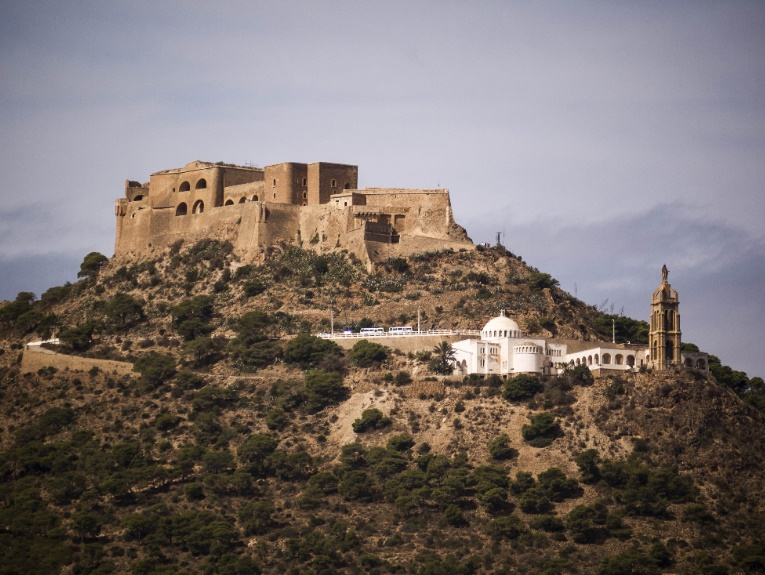
Photo: commons.wikimedia.org Video: independenzawebtv -
Bey's Palace is a historically significant palace in Constantine, Algeria. The palace was one of the primary attractions during Constantine's designation as the Arab Capital of Culture in 2015.
During the reign of Ahmed Bey ben Mohamed Chérif, the palace was built. The construction began in 1825 and was completed in 1835, two years before Constantine fell under French rule. For the architectural design, Ahmad Bay enlisted the help of a Genovese engineer, Chiavino, and two well-known artists, Al-Jabari and Al-Khatabi.
When the inauguration began in 1835-36, Ahmed Bey lived in the palace as the monarch. Ahmed's delight in this magnificent location was short-lived. The French forced him out two years later and transformed the palace into their headquarters, then with independence, the Algerian troops came in and built up camp.
Bey's Palace is made up of three rooms and a lawn with orange and palm trees. The suites are linked by a corridor with arcs supported by 266 marble columns. There are also three courtyards and two marble fountains. The ceilings are also marble tiled. There are 540 cedar wood doors etched and carved with various sculptures and decorations. More than 2,000 square meters of palace walls were painted with paintings illustrating Ahmed Bey's journeys to Alexandria, Tripoli, and Algeria, as well as 15 months of travel to Istanbul, Cairo, and Hejaz in 1818 and 1819, as well as additional travels before and during his tenure as Bey of Constantine.
Location: Constantine, Algeria
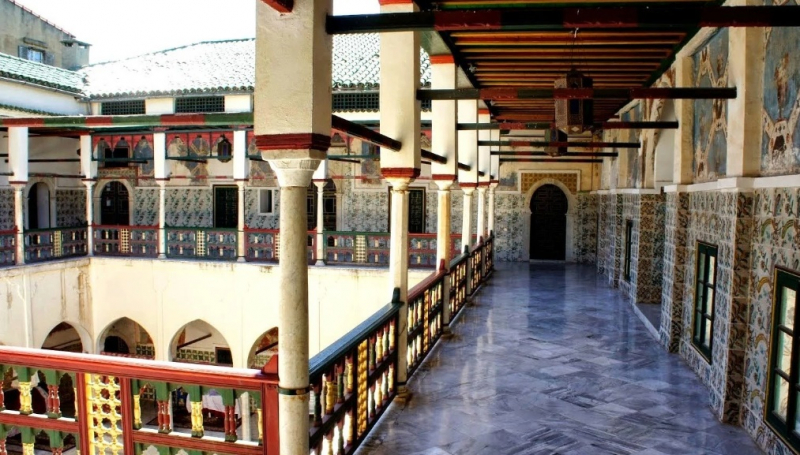
Photo: middleeasteye.net Video: Radouane HD


























